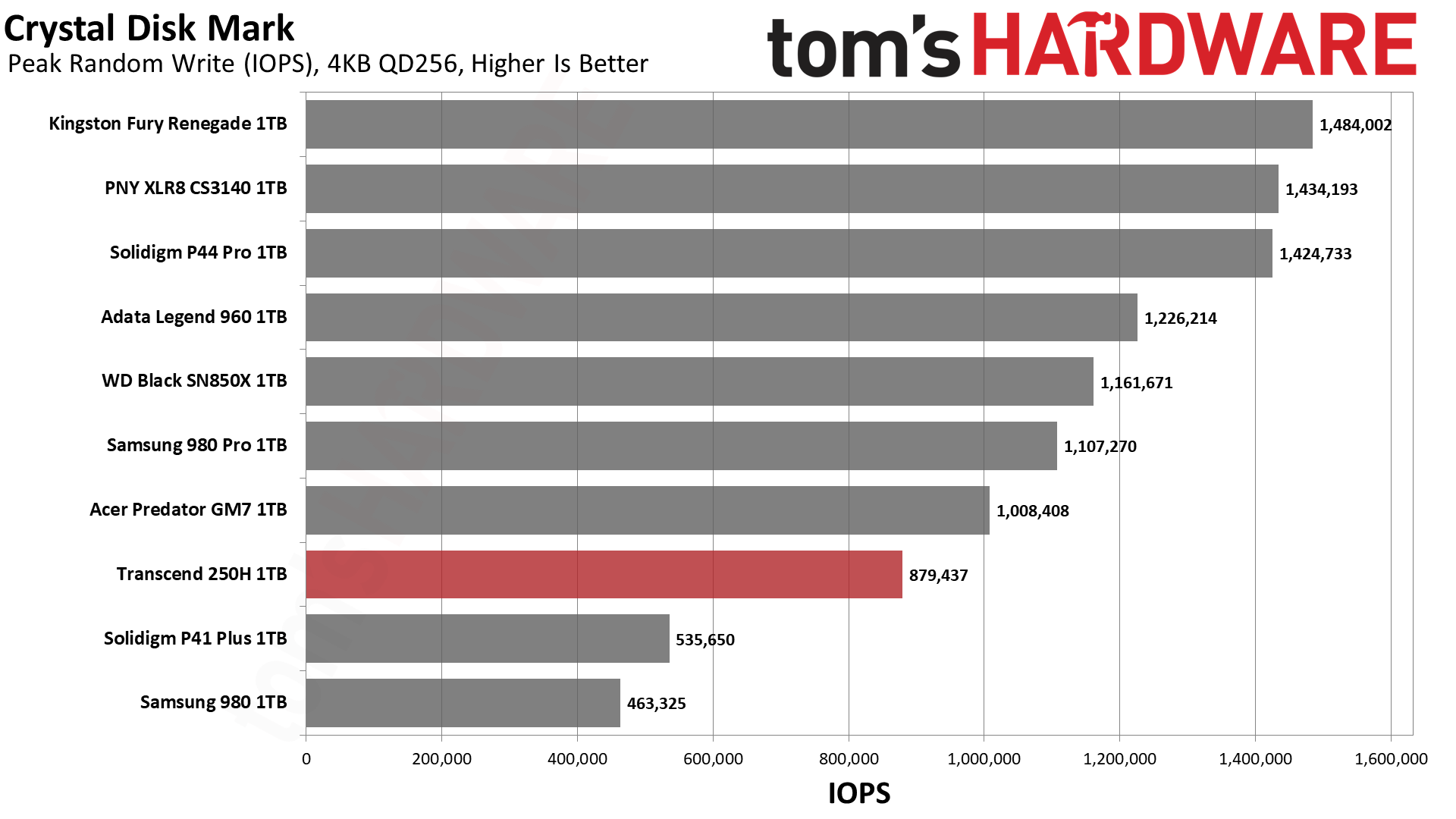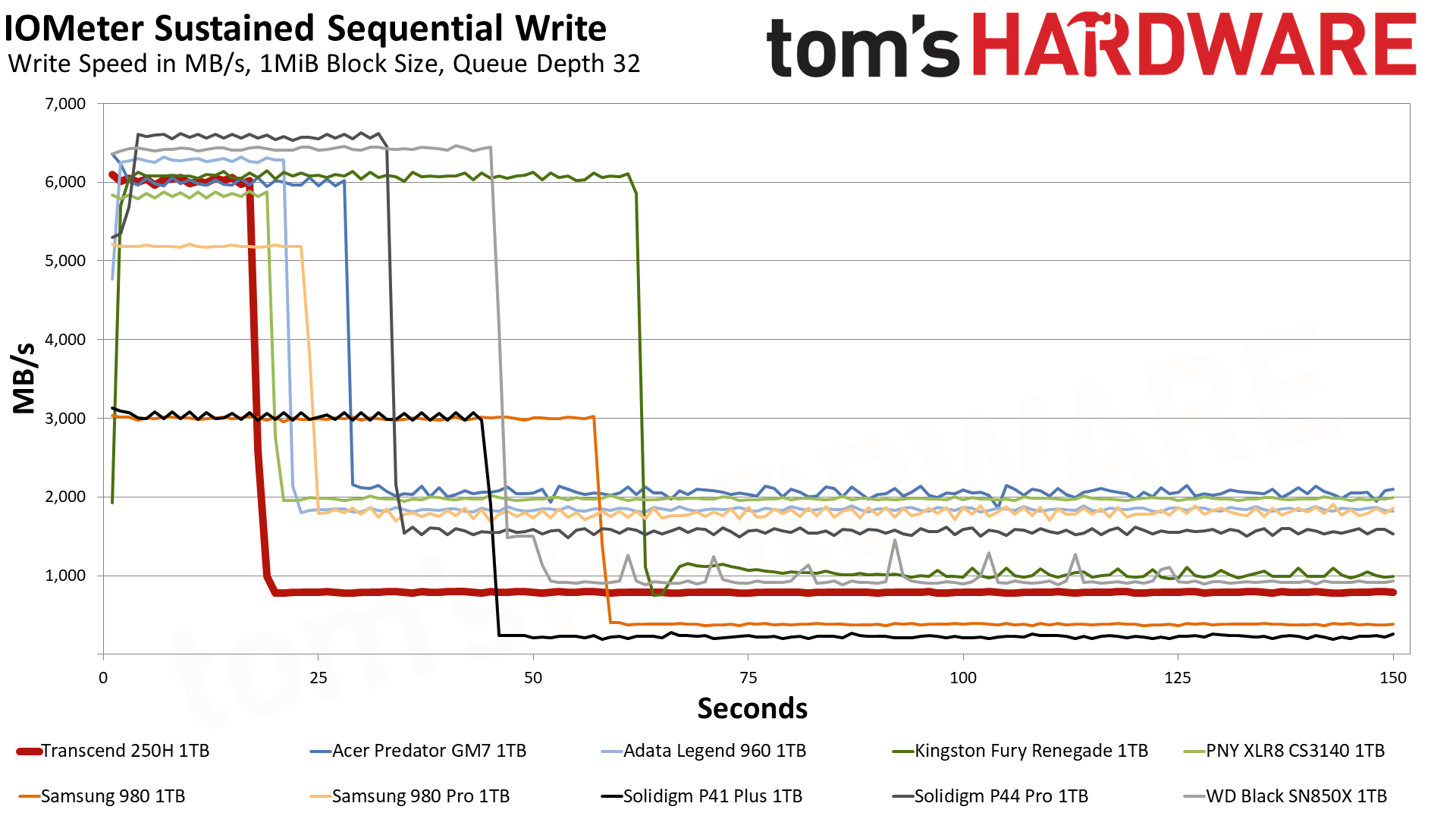Why you can trust Tom's Hardware
Comparison Products
We tested the Transcend 250H against the Solidigm P44 Pro, the WD Black SN850X, the Samsung 980 and 980 Pro, the Acer Predator GM7, the PNY XLR8 CS3140, the Kingston Fury Renegade, and the slower Solidigm P41 Plus. More critically, we have included the ADATA Legend 960 - more or less the same as the Legend 960 Max - which uses the same controller as the 250H. We have used data from the 1TB Legend 960 rather than the 2TB from our original review, for a better direct comparison.
Trace Testing - 3DMark Gaming Storage Benchmark
Built for gamers, 3DMark’s Storage Benchmark focuses on real-world gaming performance. Each round in this benchmark stresses storage based on gaming activities including loading games, saving progress, installing game files, and recording gameplay video streams.



The 250H is below average in the 3DMark bandwidth benchmarks, and its latency is higher than the similar Legend 960.
Trace Testing – PCMark 10 Storage Benchmark
PCMark 10 is a trace-based benchmark that uses a wide-ranging set of real-world traces from popular applications and everyday tasks to measure the performance of storage devices.



The 250H is mediocre to below average in PCMark 10, too. Once again, its latency is worse than the Legend 960’s, which impacts responsiveness.
Transfer Rates – DiskBench
We use the DiskBench storage benchmarking tool to test file transfer performance with a custom, 50GB dataset. We copy 31,227 files of various types, such as pictures, PDFs, and videos to a new folder and then follow-up with a reading test of a newly-written 6.5GB zip file.



The high-end PCIe 4.0 drives are reaching the limits of what’s possible in terms of bandwidth with this interface. As such, the 250H is essentially tied with the rest, though it does pull ahead in the write transfer portion of the test.
Get Tom's Hardware's best news and in-depth reviews, straight to your inbox.
Synthetic Testing - ATTO / CrystalDiskMark
ATTO and CrystalDiskMark (CDM) are free and easy-to-use storage benchmarking tools that SSD vendors commonly use to assign performance specifications to their products. Both of these tools give us insight into how each device handles different file sizes.












The 250H has no problem scaling in ATTO with the Legend 960. Read performance at smaller block sizes leaves something to be desired, but write performance is good. Sequential performance, in general, is merely average in CDM, with the Legend edging it out on the whole.
Random I/O latency is where we see a larger difference. Low queue depth, random read latency is particularly bad. Random low queue depth write latency is a bit better but still worse than the Legend 960. Maximum IOPS for both at high queue depth also suffers. While it’s possible a variety of things could cause this, it’s likely the controller is not well-optimized for this flash.
Sustained Write Performance and Cache Recovery
Official write specifications are only part of the performance picture. Most SSDs implement a write cache, which is a fast area of (usually) pseudo-SLC programmed flash that absorbs incoming data. Sustained write speeds can suffer tremendously once the workload spills outside of the cache and into the "native" TLC or QLC flash.
We use Iometer to hammer the SSD with sequential writes for 15 minutes to measure both the size of the write cache and performance after the cache is saturated. We also monitor cache recovery via multiple idle rounds.



The 1TB 250H writes up to 6 GB/s for over 17 seconds in pSLC mode. This is not a huge cache at 100GB, but it’s not small, either. The drive then hits a TLC mode below 800 MB/s for steady state write performance of 788 MB/s. The Legend 960, which has a faster pSLC write speed and larger cache, is significantly faster also in TLC, hitting a steady state of 1,849 MB/s. This is due to the differences in flash, primarily Micron’s TLC having double the planar interleaving. Both drives will scale up to about double the TLC speed if purchased at 2TB. The 250H did recover its cache fairly quickly in our testing, which can help compensate.
Does sustained write performance matter? In most cases, not really, although there are certainly edge cases where it will. The results of this test can also reveal more about the hardware. In this case, combined with other benchmark results, it’s easy to see that BiCS5 suffers compared to Micron’s TLC. The difference is larger than expected, so it’s possible SMI’s newer controllers are not a good pairing with BiCS5.
Power Consumption
We use the Quarch HD Programmable Power Module to gain a deeper understanding of power characteristics. Idle power consumption is an important aspect to consider, especially if you're looking for a laptop upgrade as even the best ultrabooks can have mediocre storage.
Some SSDs can consume watts of power at idle while better-suited ones sip just milliwatts. Average workload power consumption and max consumption are two other aspects of power consumption, but performance-per-watt is more important. A drive might consume more power during any given workload, but accomplishing a task faster allows the drive to drop into an idle state more quickly, ultimately saving energy.
For temperature recording we currently poll the drive’s primary composite sensor during testing with a 24C ambient.




We would not expect BiCS to be as efficient, either, and that is the result revealed by our power testing. The 250H is significantly less efficient than the Legend 960. This probably isn’t a huge deal in a desktop or PS5, and the heatsink precludes easy laptop installation. Transcend’s 250S, which lacks a heatsink, should act similarly. This is not the best result when combined with the drive’s generally mediocre performance.
One bright spot is the drive’s thermal test results. During testing, we hit a maximum of around 62C, far away from any sort of throttling. The 250H does at least run cool. This is significantly cooler than the bare Legend 960, although the Legend 960 Max has a heatsink that keeps temperatures more respectable.
Test Bench and Testing Notes
| CPU | Intel Core i9-12900K |
| Motherboard | Asus ROG Maximus Z790 Hero |
| Memory | 2x16GB G.Skill DDR5-5600 CL28 |
| Graphics | Intel Iris Xe UHD Graphics 770 |
| CPU Cooling | Enermax Aquafusion 240 |
| Case | Cooler Master TD500 Mesh V2 |
| Power Supply | Cooler Master V850 i Gold |
| OS Storage | Sabrent Rocket 4 Plus 2TB |
| Operating System | Windows 11 Pro |
We use an Alder Lake platform with most background applications such as indexing, Windows updates, and anti-virus disabled in the OS to reduce run-to-run variability. Each SSD is prefilled to 50% capacity and tested as a secondary device. Unless noted, we use active cooling for all SSDs.
Conclusion
The Transcend 250H doesn’t have much going for it over its direct competition, but it’s also not the worst drive we’ve tested. We would have liked to have seen better performance and efficiency, but this combination of controller and flash just doesn’t seem to get the job done. The drive does at least have a good warranty with basic software support, including cloning, and the heatsink keeps it cool during operation. The downsides could even be overlooked if the drive were priced more favorably.
We don’t review many Transcend SSDs as the company’s presence in the U.S. is somewhat limited. However, Transcend sells a lot of drives worldwide and is effectively an OEM choice in a lot of places. This is important because counterfeiting and the repurposing of poor flash is not uncommon, especially in the currently contentious NAND market. Many manufacturers will also change hardware on a whim, while Transcend attempts to be consistent. We feel this is the saving grace of the 250H, as the drive is still plenty fast for everyday use with PCs that aren't focused on providing leading-edge performance.
The closest direct competitor to the 250H and its 250S sibling would be the ADATA Legend 960 Max and Legend 960, respectively. In our testing, the ADATA drives with Micron’s flash were superior in almost every way. Those SSDs performed satisfactorily against other competing high-end PCIe 4.0 drives in our testing, but there are better options like the WD Black SN850X, the Solidigm P44 Pro, and the Samsung 990 Pro.
The 250H still manages to bring some uplift over mid-range and budget drives like the Solidigm P41 Plus, but basically it has to undercut the direct competition to be worthwhile. Ultimately, this makes it an ideal choice in areas where competition has limited availability, but it shouldn't be your first choice.
MORE: Best SSDs
MORE: Best External SSDs and Hard Drives
MORE: How We Test HDDs And SSDs
MORE: All SSD Content

Shane Downing is a Freelance Reviewer for Tom’s Hardware US, covering consumer storage hardware.
